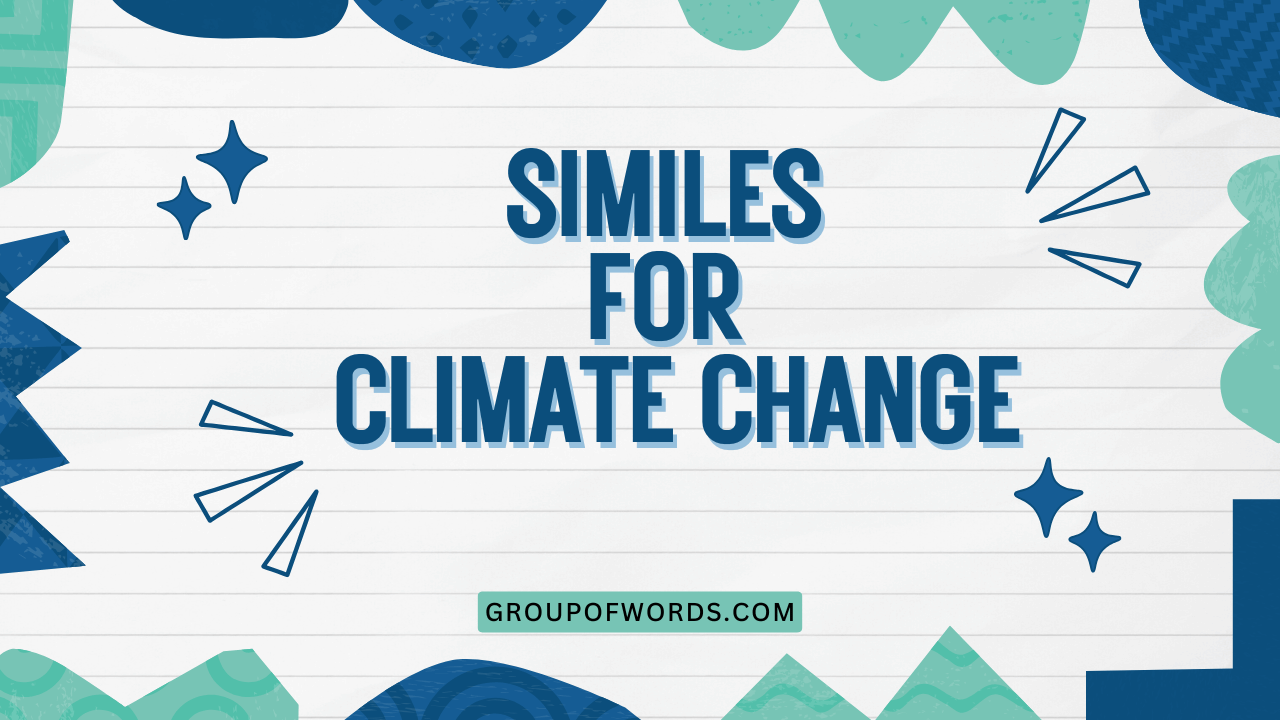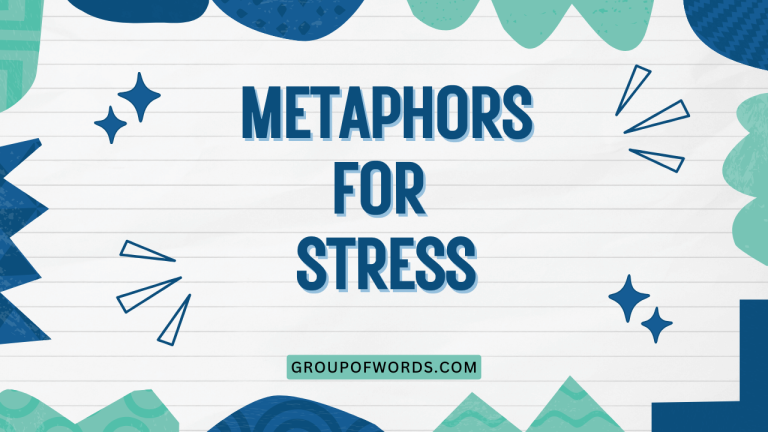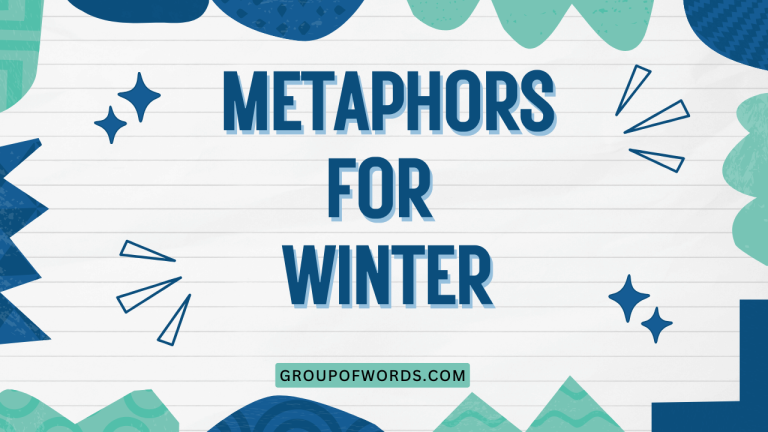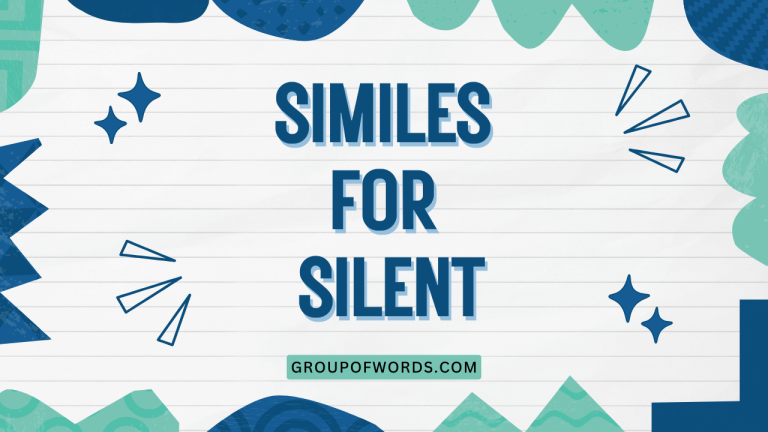Similes for Climate Change: A Comprehensive Guide
Climate change, a complex and multifaceted issue, often requires vivid and relatable language to convey its severity and impact. Similes, powerful figures of speech that compare two unlike things using “like” or “as,” provide an effective way to illustrate the abstract and sometimes overwhelming nature of environmental challenges.
Understanding how to use similes effectively can enhance our communication about climate change, making it more engaging and easier to grasp. This article explores the definition, structure, types, and usage of similes in the context of climate change, providing numerous examples and practical exercises to help you master this rhetorical device.
This guide is beneficial for students, educators, writers, and anyone seeking to communicate more effectively about the urgent issues surrounding climate change.
Table of Contents
- Definition of Similes
- Structural Breakdown of Similes
- Types of Similes
- Examples of Similes for Climate Change
- Usage Rules for Similes
- Common Mistakes When Using Similes
- Practice Exercises
- Advanced Topics in Similes
- Frequently Asked Questions (FAQs)
- Conclusion
Definition of Similes
A simile is a figure of speech that compares two different things using the words “like” or “as.” Its primary function is to create a vivid image or enhance understanding by drawing a parallel between something familiar and something less so. Similes are essential tools in descriptive writing and persuasive communication, allowing writers and speakers to convey complex ideas in a relatable and memorable way. In the context of climate change, similes can help illustrate the abstract concepts and far-reaching consequences of environmental degradation.
Similes are classified as a type of figurative language, contrasting with literal language, which conveys the direct meaning of words. Figurative language uses figures of speech to create an image, association, or other effect in the reader’s or listener’s mind. Similes, metaphors, personification, and hyperbole are all examples of figurative language. The effectiveness of a simile lies in the strength and relevance of the comparison it makes.
Similes are used in various contexts, from literature and poetry to everyday conversation and scientific communication. They are particularly useful in explaining complex or abstract concepts by relating them to something more concrete and familiar.
In the context of climate change, similes can help bridge the gap between scientific data and public understanding, making the issue more accessible and engaging.
Structural Breakdown of Similes
A simile typically consists of three key elements: the topic (the subject being described), the connecting word (either “like” or “as”), and the vehicle (the thing to which the topic is being compared). Understanding these components is crucial for constructing effective and meaningful similes. Sometimes, the order of these elements can be changed for stylistic effect, but the core components remain the same.
The basic structure of a simile can be represented as follows: Topic + Connecting Word + Vehicle. For example, in the simile “The greenhouse effect is like a blanket trapping heat,” the topic is “the greenhouse effect,” the connecting word is “like,” and the vehicle is “a blanket trapping heat.” This structure provides a clear and concise comparison, making the concept easier to understand.
Variations in simile structure can include the use of different connecting words or phrases, such as “similar to,” “resembles,” or “comparable to.” Additionally, the order of the topic and vehicle can be reversed for emphasis or stylistic effect. However, the fundamental principle of comparison remains the same.
For instance, “A blanket trapping heat is like the greenhouse effect” still conveys the same comparison, but with a slightly different emphasis.
Types of Similes
Similes can be categorized based on the type of comparison they make. Some similes focus on similarity in appearance, while others emphasize similarity in behavior, function, or effect. Understanding these different types can help you choose the most appropriate simile for a given context. Moreover, similes can be categorized by their level of originality and impact.
Descriptive Similes
Descriptive similes focus on physical attributes or characteristics. These similes often compare the appearance of something related to climate change to something more familiar.
For example, “The melting glaciers are like tears on the face of the Earth” describes the visual image of melting ice.
Functional Similes
Functional similes compare the way something works or behaves. These types of similes are useful for explaining complex processes or mechanisms related to climate change.
An example is, “The atmosphere acts as a shield, like sunscreen, protecting us from harmful radiation,” which explains the protective function of the atmosphere.
Emotive Similes
Emotive similes evoke a specific feeling or emotion. These similes are particularly effective for conveying the emotional impact of climate change.
For example, “The loss of biodiversity feels like losing a part of ourselves” conveys a sense of personal loss and grief.
Original vs. Clichéd Similes
Original similes offer fresh and creative comparisons, while clichéd similes are overused and lack impact. It’s important to strive for originality in your similes to make your writing more engaging and memorable. For example, instead of saying “The weather is as unpredictable as a rollercoaster,” which is a common cliché, you could say “The weather is as unpredictable as a politician’s promises,” which offers a more novel and engaging comparison.
Examples of Similes for Climate Change
The following tables provide a range of examples of similes related to climate change, categorized by different aspects of the issue. These examples illustrate how similes can be used to describe the causes, effects, and potential solutions to climate change in a vivid and engaging way.
Each table includes a variety of similes to provide a broad understanding of how they can be applied.
Similes Describing the Effects of Climate Change
This table showcases similes that vividly depict the various impacts and consequences of climate change, such as rising sea levels, extreme weather events, and ecological disruptions. These examples aim to make the abstract effects of climate change more tangible and emotionally resonant.
| Simile | Explanation |
|---|---|
| The rising sea levels are like a slow, relentless tide consuming the coastline. | Illustrates the gradual but unstoppable nature of sea-level rise. |
| The heatwaves are as oppressive as a furnace blasting hot air. | Conveys the intense and unbearable nature of extreme heat. |
| Deforestation is like a wound on the Earth’s surface, slowly festering. | Highlights the damaging and long-lasting impact of deforestation. |
| The melting glaciers are like tears streaming down the face of the planet. | Evokes a sense of sadness and loss associated with glacial melt. |
| The extinction of species is like a library burning down, losing invaluable knowledge. | Emphasizes the irreversible loss of biodiversity. |
| The acidification of the oceans is like a silent poison spreading through the sea. | Highlights the insidious and destructive nature of ocean acidification. |
| The spread of wildfires is like an uncontrolled beast devouring everything in its path. | Conveys the destructive power and rapid spread of wildfires. |
| The drought is as parched as a desert, sucking the life out of the land. | Illustrates the severe dryness and desolation caused by drought. |
| The coral reefs are bleaching like ghosts in the ocean, fading away. | Evokes a sense of loss and fragility of coral reef ecosystems. |
| The permafrost is thawing like an ancient freezer unlocking its secrets. | Emphasizes the release of stored greenhouse gases from thawing permafrost. |
| The storms rage like furious gods unleashing their wrath upon the earth. | Highlights the intense and destructive power of extreme weather events. |
| The desertification spreads like a disease, consuming fertile lands. | Illustrates the rapid and destructive advancement of desertification. |
| The polar ice caps are shrinking like ice cubes in a hot drink. | Conveys the rapid rate at which polar ice is melting. |
| The climate refugees are as displaced as leaves scattered by the wind. | Emphasizes the vulnerability and displacement of people affected by climate change. |
| The polluted air hangs like a heavy shroud over the city. | Conveys the suffocating and oppressive nature of air pollution. |
| The rising temperatures are as relentless as a fever that won’t break. | Illustrates the persistent and concerning increase in global temperatures. |
| The ecosystems are collapsing like dominoes, one after another. | Highlights the interconnectedness and cascading effects of ecosystem collapse. |
| The impact of climate change is like ripples in a pond, spreading far and wide. | Conveys the extensive and far-reaching consequences of climate change. |
| The forests are burning like torches, illuminating the sky with destruction. | Emphasizes the severity and visual impact of forest fires. |
| The soil erosion is like skin peeling off the land, leaving it vulnerable. | Illustrates the damaging effects of soil erosion on land fertility and stability. |
| The rising acidity of rainwater is like a corrosive bath, damaging the environment. | Highlights the destructive effect of acid rain on ecosystems. |
| The environmental damage is accumulating like unpaid debt with growing interest. | Conveys the long-term and escalating consequences of environmental degradation. |
| The deforestation spreads like an aggressive cancer, eating away at the green lungs of the planet. | Highlights the irreversible and destructive nature of deforestation. |
Similes Describing the Causes of Climate Change
This table focuses on similes that illustrate the human activities and natural processes contributing to climate change, such as greenhouse gas emissions, deforestation, and industrial pollution. These examples aim to clarify the connections between our actions and their environmental consequences.
| Simile | Explanation |
|---|---|
| Greenhouse gas emissions are like a blanket wrapped around the Earth, trapping heat. | Illustrates how greenhouse gases contribute to global warming. |
| Deforestation is like removing the lungs of the Earth, reducing its ability to breathe. | Highlights the role of forests in absorbing carbon dioxide. |
| Burning fossil fuels is like adding fuel to a fire, intensifying global warming. | Conveys the direct link between fossil fuel combustion and rising temperatures. |
| Industrial pollution is like a toxic cloud poisoning the air and water. | Emphasizes the harmful effects of industrial waste on the environment. |
| Consumerism is like a never-ending appetite, constantly demanding more resources. | Highlights the unsustainable nature of excessive consumption. |
| The overuse of pesticides is like a chemical warfare on the ecosystem. | Conveys the damaging effects of pesticides on biodiversity and environmental health. |
| Urban sprawl is like a creeping vine suffocating the natural landscape. | Illustrates the destructive impact of urban development on natural habitats. |
| The destruction of wetlands is like draining the kidneys of the Earth, impairing its ability to filter water. | Highlights the importance of wetlands in water purification and flood control. |
| The melting permafrost is like a Pandora’s Box releasing ancient greenhouse gases. | Emphasizes the potential for further warming from thawing permafrost. |
| Our reliance on cars is like an addiction, difficult to break and harmful to our health. | Conveys the negative environmental and health impacts of car dependency. |
| Fossil fuel dependence is like a chain, binding us to a destructive path. | Highlights the difficulty and urgency of transitioning away from fossil fuels. |
| Plastic pollution is like a plague, infesting the oceans and land. | Illustrates the pervasive and harmful nature of plastic waste. |
| Overfishing is like mining the oceans, depleting marine resources. | Conveys the unsustainable nature of excessive fishing practices. |
| Agricultural runoff is like a dirty river, polluting waterways with fertilizers and pesticides. | Highlights the harmful effects of agricultural practices on water quality. |
| Methane emissions are like a silent but potent force driving climate change. | Emphasizes the significant contribution of methane to global warming. |
| The throwaway culture is like a wasteful machine constantly generating trash. | Illustrates the unsustainable nature of a society focused on disposable products. |
| The burning of rainforests is like destroying precious libraries of biodiversity. | Conveys the irreversible loss of species and ecosystems from rainforest destruction. |
| The exploitation of natural resources is like robbing future generations of their inheritance. | Highlights the ethical implications of unsustainable resource use. |
| The carbon footprint of air travel is like a heavy weight on the planet. | Emphasizes the significant environmental impact of air transportation. |
| The release of black carbon is like soot darkening the snow, accelerating melting. | Illustrates the impact of black carbon on snow and ice melt. |
| The use of aerosols is like playing with a loaded gun, risking unintended consequences. | Highlights the potential risks and uncertainties associated with geoengineering techniques. |
| The lack of regulation is like leaving the door open for environmental destruction. | Conveys the importance of strong environmental policies and enforcement. |
| The pursuit of economic growth at all costs is like chasing a mirage, ignoring the real costs. | Highlights the need for sustainable economic development. |
Similes Describing Solutions to Climate Change
This table presents similes that illustrate potential solutions and actions to mitigate climate change, such as renewable energy, sustainable practices, and conservation efforts. These examples aim to inspire hope and highlight the positive impact of proactive measures.
| Simile | Explanation |
|---|---|
| Renewable energy is like a breath of fresh air, cleaning the planet’s atmosphere. | Highlights the positive impact of renewable energy on air quality. |
| Planting trees is like giving the Earth a new set of lungs, helping it breathe again. | Emphasizes the role of trees in absorbing carbon dioxide and producing oxygen. |
| Sustainable agriculture is like nurturing the soil, ensuring long-term food security. | Conveys the importance of soil health in sustainable farming practices. |
| Conservation is like protecting a treasure, preserving it for future generations. | Highlights the value of preserving natural resources and biodiversity. |
| Reducing carbon footprint is like losing weight, improving the planet’s health. | Conveys the positive impact of reducing greenhouse gas emissions. |
| Transitioning to electric vehicles is like switching from cigarettes to fresh air. | Highlights the health and environmental benefits of electric vehicles. |
| Investing in green technology is like planting seeds for a sustainable future. | Emphasizes the long-term benefits of investing in environmentally friendly technologies. |
| Education is like equipping people with tools to understand and address climate change. | Highlights the importance of education in promoting climate action. |
| International cooperation is like a strong chain, linking countries together to tackle climate change. | Conveys the importance of global collaboration in addressing climate change. |
| Adopting a circular economy is like closing the loop, minimizing waste and maximizing resource use. | Highlights the benefits of a circular economy in reducing environmental impact. |
| Carbon capture technology is like a giant vacuum cleaner, sucking carbon dioxide from the air. | Conveys the potential of carbon capture technologies to remove greenhouse gases. |
| Building resilient infrastructure is like fortifying a city against future disasters. | Highlights the importance of preparing for the impacts of climate change. |
| Promoting energy efficiency is like tightening the seal, preventing energy waste. | Conveys the benefits of reducing energy consumption. |
| Protecting wetlands is like safeguarding a natural sponge, absorbing floodwaters. | Highlights the importance of wetlands in flood control and water management. |
| Sustainable forestry is like carefully managing a garden, ensuring its long-term health. | Conveys the benefits of responsible forest management practices. |
| Restoring degraded ecosystems is like patching up a wounded landscape, helping it heal. | Highlights the importance of ecosystem restoration in improving environmental health. |
| Promoting plant-based diets is like lightening the load on the planet, reducing environmental impact. | Conveys the benefits of reducing meat consumption for environmental sustainability. |
| Supporting local food systems is like strengthening the community, fostering resilience. | Highlights the benefits of local food systems for environmental and social sustainability. |
| Implementing carbon pricing is like putting a cost on pollution, incentivizing cleaner practices. | Conveys the potential of carbon pricing to drive emissions reductions. |
| Developing drought-resistant crops is like creating armor for agriculture against climate change. | Highlights the importance of adapting agriculture to changing climate conditions. |
| Using public transport is like sharing the load, reducing collective impact. | Conveys the benefits of reducing individual carbon footprints by using collective transit. |
| Investing in climate research is like shining a light on a path forward, guiding us toward solutions. | Highlights the importance of scientific research in addressing climate change. |
| Creating green jobs is like building a ladder to a sustainable economy, providing employment and environmental benefits. | Conveys the potential for creating economic opportunities through climate action. |
Usage Rules for Similes
Using similes effectively requires adherence to certain rules to ensure clarity and impact. The main rules include ensuring a clear comparison, avoiding clichés, and maintaining consistency in tone. By following these guidelines, you can create similes that enhance your writing and communication.
Ensure a Clear Comparison: The two elements being compared should have a recognizable similarity. The connection should be logical and easy to understand. If the comparison is too obscure or far-fetched, it will confuse the reader rather than enlighten them.
Avoid Clichés: Overused similes can make your writing sound unoriginal and dull. Strive for fresh and creative comparisons that will capture the reader’s attention. Instead of using common similes, try to come up with new and imaginative ways to describe something.
Maintain Consistency in Tone: The tone of your simile should match the overall tone of your writing. Avoid using humorous or lighthearted similes in serious or somber contexts, as this can create a jarring effect. Make sure the simile fits the mood and purpose of your message.
Common Mistakes When Using Similes
Several common mistakes can undermine the effectiveness of similes. These include mixing metaphors and similes, using inappropriate comparisons, and creating unclear or confusing similes. Recognizing and avoiding these errors can significantly improve your writing.
Mixing Metaphors and Similes: Metaphors and similes are similar, but they should not be mixed within the same sentence. A simile uses “like” or “as” to make a comparison, while a metaphor states that one thing *is* another. Mixing the two can create a confusing and grammatically incorrect sentence.
Inappropriate Comparisons: The elements being compared should be logically related. Comparing unrelated things can result in a simile that is nonsensical or ineffective. Ensure that the comparison makes sense in the context of your writing.
Unclear or Confusing Similes: A simile should enhance understanding, not create confusion. If the comparison is too vague or complex, it will fail to achieve its purpose. Keep your similes clear, concise, and easy to understand.
Here are some examples of common mistakes and corrections:
| Incorrect Simile | Corrected Simile | Explanation |
|---|---|---|
| The climate change is a monster, like a gentle breeze. | Climate change is like a relentless storm, growing stronger each year. | The original sentence mixes a metaphor (“a monster”) with a simile and also uses an inappropriate comparison (“gentle breeze”). |
| Deforestation is like a tree. | Deforestation is like removing the lungs of the earth. | The original sentence is too vague and doesn’t provide a meaningful comparison. |
| The rising sea levels are as high as a building. | The rising sea levels are like an encroaching tide, threatening coastal communities. | The original sentence is a literal comparison rather than a figurative one. |
Practice Exercises
These exercises are designed to help you practice using similes effectively. Each exercise focuses on a different aspect of climate change, allowing you to apply your knowledge in various contexts.
Answer keys are provided to help you assess your progress.
Exercise 1: Identifying Similes
Identify the similes in the following sentences and explain what two things are being compared.
| Question | Answer |
|---|---|
| 1. The desert is as dry as a bone. | Simile: “as dry as a bone.” Comparison: The dryness of the desert is compared to the dryness of a bone. |
| 2. The melting glaciers are like tears on the face of the Earth. | Simile: “like tears on the face of the Earth.” Comparison: Melting glaciers are compared to tears. |
| 3. His heart was a stone. | This is a metaphor, not a simile. |
| 4. The polluted air hung like a heavy shroud over the city. | Simile: “like a heavy shroud.” Comparison: The polluted air is compared to a heavy shroud. |
| 5. Renewable energy is like a breath of fresh air. | Simile: “like a breath of fresh air.” Comparison: Renewable energy is compared to a breath of fresh air. |
| 6. The storm raged as a furious beast. | Simile: “as a furious beast.” Comparison: The storm is compared to a furious beast. |
| 7. Deforestation is like removing the lungs of the Earth. | Simile: “like removing the lungs of the Earth.” Comparison: Deforestation is compared to removing the lungs of the Earth. |
| 8. The drought spread like a disease. | Simile: “like a disease.” Comparison: The spread of the drought is compared to the spread of a disease. |
| 9. Climate change is a ticking time bomb. | This is a metaphor, not a simile. |
| 10. The coral reefs are bleaching like ghosts. | Simile: “like ghosts.” Comparison: The bleaching coral reefs are compared to ghosts. |
Exercise 2: Completing Similes
Complete the following similes related to climate change.
| Question | Answer |
|---|---|
| 1. The heatwaves are as oppressive as __________. | The heatwaves are as oppressive as a furnace. |
| 2. The rising sea levels are like __________. | The rising sea levels are like a slow, relentless tide. |
| 3. Reducing carbon footprint is like __________. | Reducing carbon footprint is like losing weight. |
| 4. The wildfires spread like __________. | The wildfires spread like an uncontrolled beast. |
| 5. The extinction of species is like __________. | The extinction of species is like a library burning down. |
| 6. The polluted air is as thick as __________. | The polluted air is as thick as pea soup. |
| 7. The desert is as barren as __________. | The desert is as barren as the surface of the moon. |
| 8. The melting ice caps are like __________. | The melting ice caps are like ice cubes in a hot drink. |
| 9. The deforested land is like __________. | The deforested land is like a raw wound. |
| 10. The lack of action on climate change is like __________. | The lack of action on climate change is like ignoring a fire alarm. |
Exercise 3: Writing Your Own Similes
Write your own similes to describe the following aspects of climate change.
| Topic | Possible Simile |
|---|---|
| 1. The impact of climate change on coastal communities | The impact of climate change on coastal communities is like a rising tide, slowly eroding their homes and livelihoods. |
| 2. The importance of reducing greenhouse gas emissions | Reducing greenhouse gas emissions is like putting a lid on a boiling pot, preventing it from overflowing. |
| 3. The role of sustainable agriculture in mitigating climate change | Sustainable agriculture is like nurturing a garden, ensuring healthy growth for years to come. |
| 4. The feeling of witnessing environmental destruction | Witnessing environmental destruction is like watching a masterpiece being vandalized, each stroke a strike against beauty and balance. |
| 5. The urgency of addressing climate change | Addressing climate change is like defusing a bomb, every second counts to prevent disaster. |
| 6. The power of collective action against climate change | Collective action against climate change is like a choir, where individual voices harmonize to create a powerful symphony of change. |
| 7. The effect of pollution on the oceans | The effect of pollution on the oceans is like a slow poison, gradually killing marine life and disrupting ecosystems. |
| 8. The resilience of nature in the face of climate change | The resilience of nature in the face of climate change is like a plant pushing through concrete, showing its unwavering determination to survive. |
| 9. The role of technology in solving climate change | Technology in solving climate change is like a toolkit, providing innovative solutions to address pressing environmental issues. |
| 10. The importance of education in raising climate change awareness | Education in raising climate change awareness is like planting seeds, nurturing understanding and inspiring action. |
Advanced Topics in Similes
For advanced learners, understanding the nuances of similes can enhance their writing and communication skills even further. Advanced topics include extended similes, implied similes, and the use of similes in persuasive rhetoric. Exploring these areas can help you craft more sophisticated and impactful similes.
Extended Similes: An extended simile is a simile that is developed over several sentences or even paragraphs. This allows for a more detailed and nuanced comparison, creating a stronger and more lasting impression on the reader. Extended similes are often used in literary writing to create vivid imagery and convey complex ideas.
Implied Similes: An implied simile is a simile in which the connecting word (“like” or “as”) is omitted. This creates a more subtle and suggestive comparison, requiring the reader to infer the relationship between the two elements. Implied similes can add depth and complexity to your writing.
Similes in Persuasive Rhetoric: Similes can be powerful tools in persuasive writing and speaking. By using vivid and relatable comparisons, you can make your arguments more compelling and memorable. Similes can also evoke emotions and create a sense of connection with your audience.
Frequently Asked Questions (FAQs)
Here are some frequently asked questions about similes and their use in the context of climate change.
- What is the difference between a simile and a metaphor?
A simile compares two things using “like” or “as,” while a metaphor states that one thing *is* another. Similes are more explicit in their comparison, while metaphors are more implicit and suggestive.
- Why are similes useful in communicating about climate change?
Similes can make complex and abstract concepts more relatable and understandable by comparing them to familiar things. This can help engage audiences and promote a deeper understanding of the issues.
- How can I avoid using clichés in my similes?
To avoid clichés, strive for originality and creativity in your comparisons. Think about unique and unexpected connections between the topic and the vehicle. Read widely and pay attention to how other writers use similes effectively.
- Can similes be used in scientific writing?
Yes, similes can be used in scientific writing to explain complex concepts in a more accessible way. However, it’s important to use similes judiciously and ensure that they are accurate and appropriate for the context.
- What are some common mistakes to avoid when using similes?
Common mistakes include mixing metaphors and similes, using inappropriate comparisons, and creating unclear or confusing similes. Always ensure that your similes are clear, logical, and consistent with the tone of your writing.
- How do I choose the right simile for a given context?
Consider the audience, the purpose of your writing, and the specific aspect of climate change you are trying to describe. Choose a simile that is relevant, engaging, and easy to understand.
- Are similes effective in all types of communication?
While similes can be effective in many types of communication, they may not be appropriate in all contexts. For example, in highly technical or formal writing, a more direct and literal approach may be preferred. Understanding your audience and the purpose of your communication is key.
- How can I improve my ability to write effective similes?
Practice writing similes regularly, read widely, and pay attention to how other writers use similes. Seek feedback from others and be open to revising and improving your similes based on their suggestions.
Conclusion
Similes are powerful tools for communicating the complexities of climate change in an accessible and engaging manner. By understanding the structure, types, and usage rules of similes, you can effectively convey the causes, effects, and potential solutions to environmental challenges.
Avoiding common mistakes and practicing regularly will help you master this rhetorical device and enhance your ability to communicate about climate change with clarity and impact.
Remember to strive for originality, maintain consistency in tone, and ensure that your comparisons are clear and logical. By incorporating these principles into your writing, you can create similes that resonate with your audience and inspire action.
As you continue to learn and grow, explore advanced topics such as extended similes and implied similes to further refine your skills and elevate your communication.






